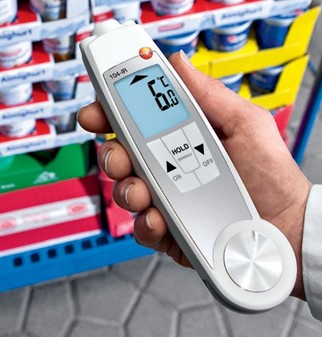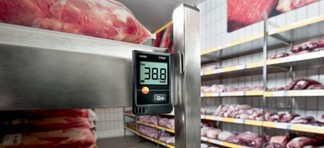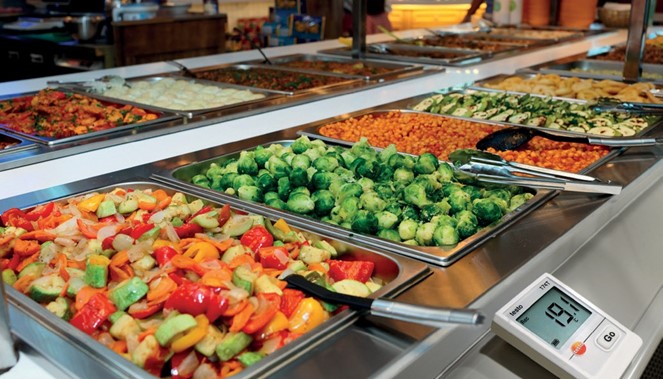Food is a matter of trust. Its quality and safety are taken for granted by guests and customers. This presents an enormous challenge to restaurateurs: They must adhere to numerous food limit values and norms (e.g. HACCP), and at the same time manage their operational procedures economically. Time and money are important influencing factors. The targeted use of measurement technology helps to ensure impeccable food quality, taking the HACCP regulations into account.
Automated climate monitoring, for example, reduces manual effort, and versatile alarm functions create more security and minimize risks. In order to use measurement technology in a truly efficient and targeted way, however, restaurateurs require specific background information. We will answer these questions for you in this document:
• Which legal limit values must be observed?
• How can these values be measured efficiently?
• How does automated climate monitoring save time and money?
• How do alarm functions reduce risks?
• In deep-frying, how can money be saved and flavour improved?
What is measured?
1. Temperature
Temperature is the physical quantity most often measured after time. Different types of thermometers are used. Digital thermometers have established themselves in professional use. These are highly accurate and robust in everyday use.
Temperature measurement methods
Spot checks with portable measuring instruments:
These are either purely measuring instruments (i.e. they only display the measurement value), or storage thermometers. These save the measured data in internal memory or transfer them by wireless LAN to a data store, for example in the Cloud. Portable measuring instruments measure the temperature either without contact by infrared, or with surface or penetration probes.
Continuous measurement:
In this case, a measuring instrument with memory remains with the goods (or in their vicinity, e.g. in the refrigerator). It records values at regular intervals and stores them in an internal memory and/or online in the Cloud.
Temperature measuring instruments
Instruments with a fixed probe:
These are suitable when the measurement task to be done is always the same, e.g. penetration measurement in refrigerated foods. An established design is the folding thermometer in which the measurement tip is directly attached to the instrument and can be folded away to save space.
Instruments with exchangeable probes:
These are recommended when different measurement tasks are required, e.g. the measurement of air temperature with an air probe in an oven, or the measurement of the core temperature of refrigerated meat with a penetration thermometer.
Important: In the food sector, the instruments should be HACCP- certified.
Thermometers should comply with the norm EN 13485. For data loggers, the norm EN 12830 applies.
2. Relative Humidity
Relative humidity is particularly important in connection with the storage of dry goods for prolonged periods of time: Condensation can be caused, and foods can take on moisture if they are stored in rooms for long periods of time. The consequence: mould growth.
3. Cooking oil quality
The properties and quality of cooking oil are altered mainly by the effects of heat and oxygen. Spent cooking oil, for example, has a negative influence on the taste of the fried goods, and can lead to stomach pains. However, replacing cooking oil too soon, when it can still be used, leads to unnecessary costs. Therefore, in order to work in an economically efficient way, yet at the same time guarantee the quality and safety of the fried goods, it is absolutely essential to measure the cooking oil quality continuously.

Penetration measurement with testo 104
Where are the measurements taken?

1. In Incoming Goods
This is where foods pass over into the responsibility of the restaurateur. He or she has to be able to rely on receiving and processing only impeccable goods. Since the cold chain and other binding regulations must be adhered to for fresh foods and deep-frozen products, these goods deserve special attention in the context of food safety.
The handover of goods generally takes place in the loading bay. Immediately after the supplier's arrival, the temperature is measured here either directly on the loading platform or in the delivery vehicle. A printed protocol can serve as proof.
Important temperature limit values
| Fresh meat (hoofed animals, large game) |
≤ +7 °C |
| Fresh poultry, rabbit, small game |
≤ +4 °C |
| Offal |
≤ +3 °C |
| Minced meat (from EU businesses). Ground meat (prepared and sold on site) |
≤ +2 °C |
| Meat preparations (from EU businesses). Meat preparations (prepared and sold on site) |
≤ +4 °C |
| Meat products, delicatessen |
≤ +7 °C |
| Fresh fish |
≤ +2 °C |
| Smoked fish |
≤ +7 °C |
| Meat, fish – frozen |
≤ -12 °C |
| Meat, fish – deep-frozen |
≤ -18 °C |
| Deep-frozen products |
≤ -18 °C |
| Ice cream |
≤ -18 °C |
| Dairy Products, recommended |
≤ +10 °C |
| Baked goods with incompletely-baked filling |
≤ +7 °C |
| Eggs (from the 18th day after laying) |
+5 to +8°C |
.
Measurement method
Non-contact infrared measurement is used especially often in Incoming Goods, as it provides results quickly and non-intrusively. However, an infrared thermometer measures only the surface temperature. In order to record the core temperature of foods, penetration measurements are usual. In both cases, the measured values are recorded manually in a test form or digitally on a PC.
Recommended measuring instrument
The penetration infrared thermometer testo 104-IR
• Combi instrument for infrared and core temperature measurements
• High-quality, robust folding joint for tough working use
• Precise 2-point laser with 10:1 optics shows the exact measurement area, allowing error-free measurements
• HACCP and EN 13485-compliant

Checking temperature in Incoming Goods with testo 104-IR
2. In Storage
As a rule, food should be used up quickly, in order to avoid unnecessary waste and guarantee food safety. The "use-by" date and the "best-before" date are the most important parameters. After the "use-by" date has been reached, increased formation of pathogens can occur. Once the "best-before" date has been reached, the quality of the product deteriorates.
Dry foods
These should be stored in stable containers, above the floor and in dry, cool, well-ventilated, clean surroundings. Humidity is an important parameter, as an excessively high relative humidity favours the growth of mould, negatively influencing the shelf life of the food.
Perishable goods
These should be stored in a refrigerator or refrigerated room, observing the prescribed temperatures.

Monitoring temperature and humidity in storage with testo 174 H
Important temperature limit values
| Fresh meat (hoofed animals, large game) |
≤ +7 °C |
| Fresh poultry, rabbit, small game |
≤ +4 °C |
| Offal |
≤ +3 °C |
| Minced meat (from EU businesses). |
≤ +2 °C |
| Ground meat (prepared and sold on site.) |
≤ +7 °C |
| Meat preparations (from EU businesses). |
≤ +4 °C |
| Meat preparations (prepared and sold on site) |
≤ +7 °C |
| Meat products, delicatessen |
≤ +7 °C |
| Fresh fish |
≤ +2 °C |
| Smoked fish |
≤ +7 °C |
| Meat, fish – frozen |
≤ -12 °C |
| Meat, fish – deep-frozen |
≤ -18 °C |
| Deep-frozen products |
≤ -18 °C |
| Ice cream |
≤ -18 °C |
| Dairy Products, recommended |
≤ +7 °C |
| Baked goods with incompletely-baked filling |
≤ +7 °C |
| Eggs (from the 18th day after laying) |
+5 to +8°C |
.
Measurement method
In the storage of foods, it is not sufficient to measure the surface and core temperature or relative humidity once a day – as that means that for the other 23 hours of the day you are in the dark about the storage conditions of your foods. The continuous measurement of temperature and humidity with data loggers or data monitoring systems is therefore preferable over manual measurement: It saves time, minimizes risks and ensures quality.
Recommended measuring instrument
Mini data logger for temperature and humidity testo 174 H
• Measurement data memory for 16,000 temperature and humidity readings
• Reliable measurement via humidity sensor with long-term stability
• Easy data transfer by USB interface, practical data analysis and documentation at a PC (software ComSoft Basic available for free download)
You want more safety and convenience?
With automatic data monitoring systems such as testo Saveris 2, temperature and humidity values are recorded automatically. In cases of deviations, you are informed by e-mail or SMS, so you are always on the safe side.
3. In Food Preparation
After the food quality has been checked in Incoming Goods and in Storage, these standards must then also be adhered to in the kitchen. Here too, the safety and quality of the foods are of paramount importance. The most important measurement parameter is temperature. It is measured not only in the foods (core temperature), but also in the oven (ambient temperature). The measurement of cooking oil quality also allows the costs to be lowered during preparation.
Measurement method
For temperature measurements in foods, penetration thermometers are used. These allow the core temperatures of foods to be measured quickly, precisely and safely. For special measurement tasks – for instance, measurements in ovens – measuring instruments with exchangeable probes are used.
With a cooking oil tester such as the testo 270, the proportion of so-called "Total Polar Materials" (TPM) in the oil is measured. If the oil is too old, it shows an increased TPM value. This results in the production of bad deep-fried goods. It can furthermore contain substances which present a risk to health. Regular measurement with the testo 270 prevents this.
The use of the measuring instrument also prevents the oil from being replaced too early. This reduces oil consumption by up to 35%, as has been confirmed in some trials with retailers and Quick Service Restaurants in South Africa.”
TPM component in cooking oil
| TPM component in cooking oil |
Fat aging level |
| < 1 to 14 % TPM |
Fresh cooking fat |
| 14 to 18 % TPM |
Slightly used |
| 18 to 22 % TPM |
Used, but still OK |
| 22 to 24 % TPM |
Heavily used, change fat |
| 24 % TPM |
Spent cooking fat |
.
Recommended measuring instrument
Penetration thermometer testo 104
- Ideal for food: HACCP-compliant, certified to EN 13485
- Rubber-coated surface for non-slip handling
- Robust metal folding joint with long measurement tip
testo 270 cooking oil tester
- Ergonomic design for safer work
- Clear, optical alarm thanks to unmistakeable traffic light display

Measuring cooking oil quality with the testo 270
Temperature measuring instrument testo 108
- Temperature measuring instrument with connected penetration probe
- Further connectable temperature probes (Type T and K) optionally available (e.g. for measurements in ovens)
- Can be used universally
4. In Food Service
This is the moment of truth. Main courses, sauces, side dishes or desserts have been prepared, all temperatures are in order and the quality is right. Now the dishes are being offered to guests on refrigerated counters, heated displays or hot buffets. In order to make sure the temperatures are spot on here too, the right measurement technology is needed. Because who wants to eat warm salads or cold meat?
Important temperature limit values
| Hot food for serving soon |
≤ +65 °C |
|
Cold dishes
Delicatessen, crudités, cold cuts,
Unpreserved salads, dressings (milk, eggs), desserts
|
≤ +7 °C |
| Ice cream (in packaging) |
≤ -18 °C |
| Ice cream (service of bulk ice cream) |
≤ -5 °C |
Measurement method
Most refrigerated furniture and warming appliances have integrated temperature sensors. However, in order to have real certainty, and to monitor the temperature at the serving counter continuously, the use of a temperature data logger is worthwhile.
Recommended measuring instruments
Mini temperature data logger testo 174 T
- Measurement data memory for 16,000 temperature readings, 500 days of battery life
- HACCP-compliant and certified according to EN 12830
- Data analysis: three possible software versions to choose from, basic software available as a free download
 Monitoring temperatures in food service with testo 174 T
Monitoring temperatures in food service with testo 174 T
The most important points at a glance.
- Refrigeration prolongs the lifetime of foods and hinders germs.
- HACCP describes the implementation of process-oriented hazards
- Where risks occur, control points must be set up and correction measures defined.
- What is not documented does not For this reason, write down the measured values or store them on a PC.
- Handheld measuring instruments for mobile measurements "in passing", data loggers and monitoring systems as transport escorts, or "semi-stationary".
- Non-contact measuring instruments measure quickly, easily and without damaging the But they only measure the surface. In case of doubt, carry out a measurement "between the packaging" or a penetration measurement (contact measurement).
- According to regulation (EC) 37/2005, temperature measuring instruments for deep-frozen foods in transport, storage and distribution must comply with the following norms:
- EN 12830 Requirements for temperature recorders
- EN 13485 Requirements for thermometers for measuring the air and product temperature for the transport, storage and distribution of chilled, frozen, deep-frozen/quick-frozen food and ice cream
Find out more at www.testo.com/en-ZA/applications/food-service








 Monitoring temperatures in food service with
Monitoring temperatures in food service with 

